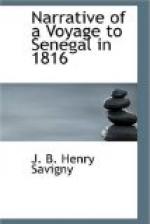When this boat left the frigate to join us, we were, at least, a league and a half distant; the captain’s barge had come some time before to take the towrope, and was at the head of the line; the smallest of the boats (the pinnace) did not take the towline; it preceded the little division, probably to take soundings.
As soon as all the boats had taken their post, cries of “Vive le Roi!” were a thousand times repeated by the men upon the raft, and a little white flag was hoisted at the top of a musket. Such was the order of the boats and the raft. The chiefs of the little division which was to conduct us to the land, had sworn not to abandon us: we are far from accusing all those gentlemen of having violated the laws of honor; but a series of circumstances obliged them to renounce the generous plan which they had formed to save us, or to perish with us. These circumstances deserve to be scrupulously examined; but our pen, guided by truth, must not fear to record facts which truth itself dictates. It is true they are of so strange a nature, that it is unpleasant to make them known. It is painful to us, to have to recount such events: we have to shew to what a degree the imagination of man is susceptible of being struck by the presence of danger, so as to make him even forget the duties which honour imposes on him. We, doubtless, admit that in forsaking the raft, the minds of those who did so, were greatly agitated, and that the desire of withdrawing themselves from danger, made them forget that a hundred and fifty unfortunate men were going to be abandoned to the most cruel sufferings. We shall relate the facts as we observed them, and as they have been communicated to us, by some of our companions in misfortune.
Before we proceed, we will describe the construction of this raft, to which a hundred and fifty persons were entrusted.
It was composed of the top-masts of the frigate, yards, fishes, boom, &c. These different pieces joined together by very strong ropes, were perfectly solid; the two principal pieces were two top-masts, which were placed at the extremity of the two sides; four other masts, two of which were of the same length and strength as the first, joined two by two, at the center of the machine, added to its solidity. The other pieces were placed within these four first but were not equal to them in length. Boards were nailed on this first foundation, and formed a kind of parapet, which would have been of great service to us if it had been higher. To render our raft still more solid, long pieces of wood had been placed across, which projected at least three metres: on the sides, there was a kind of railing, but it was not above forty centimetres in height: it would have been easy to add some crotches to it, which would have formed a breast-work of sufficient height; but it was not done, probably because those who had the machine built, were not to be exposed upon it. To the ends of the top-masts, two top-gallant yards




